WHAT TO EXPECT ON KILIMANJARO
P repare for an unforgettable journey up Kilimanjaro with our expert mountain crew by your side every step of the way. Our team is dedicated to ensuring your comfort and enjoyment throughout the expedition.
You’ll be accompanied by a seasoned chief guide, assistant guide(s), a skilled cook, and a team of porters who handle camp setup, meal preparation, water boiling, and gear transportation, allowing you to focus on the adventure ahead.
Your personal gear will be divided between a manageable daypack (30-35 liters) and a duffel bag with the rest of your items carried by the porters. This will give you the freedom to explore without being weighed down. With a maximum of 10 clients per climb and a generous staff-to-client ratio, you can rest assured that you’ll receive personalized attention and care.
So lace up your boots and get ready to conquer Kilimanjaro while we take care of the logistics, ensuring your journey is as enjoyable and memorable as possible.
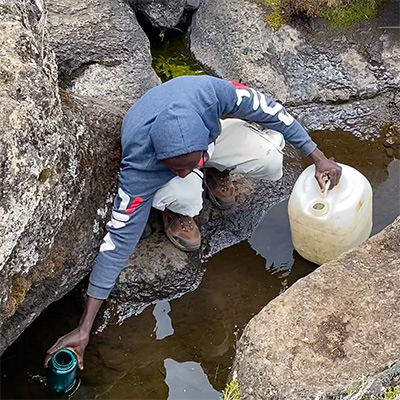
WHAT DO I DO ON KILIMANJARO?
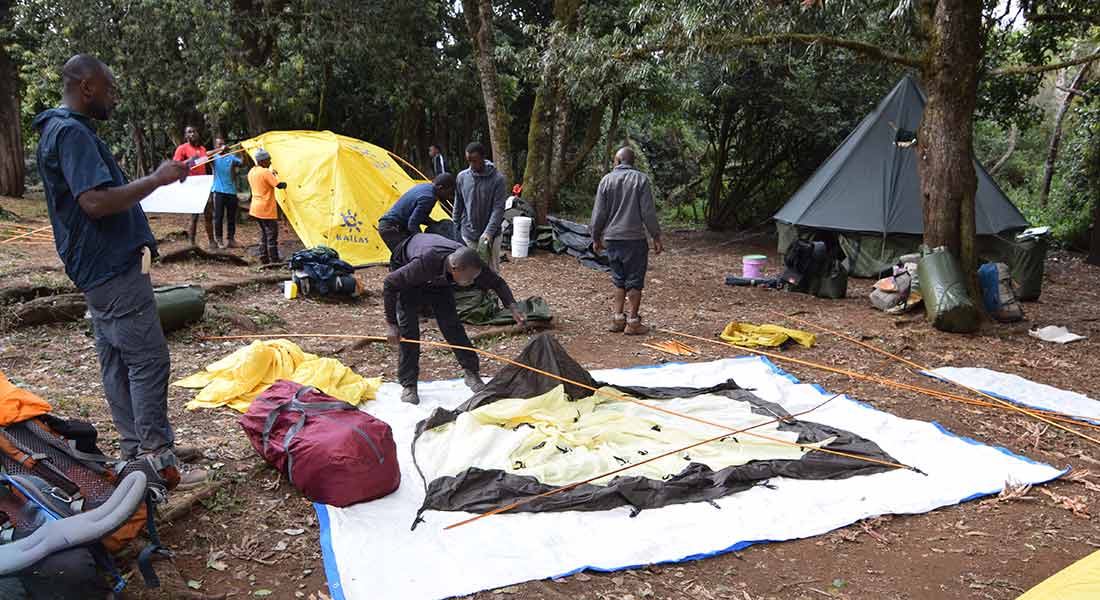
S ince our guide and porters are doing all the work, the only thing you need to do is enjoy your climb. While you are hiking, take pictures and videos. Stop and enjoy the scenery as often as you like. After all, this may be the only time you are on Kilimanjaro so make the most of it.
We want you to be as comfortable as possible. Spend time at camp resting and exploring. You can also read, clean up, stretch, and nap. We will bring you a warm bowl of water each day to wash up.
Make sure you are available for the evening briefing. The guide will let you know when that will happen. During the briefing, the guide will tell you how much water to bring for the next day as well as what to have in your daypack. They will discuss the day and how you are feeling and how much water you drank. During this time they will also perform the daily health check. They will record your blood oxygen saturation levels and log the results. They will also ask several questions about how you are feeling. Let them know if anything is bothering you.
After the briefing, spend time getting your clothing, snacks, and water prepared for the next day.

WHAT IS THE DAILY SCHEDULE?
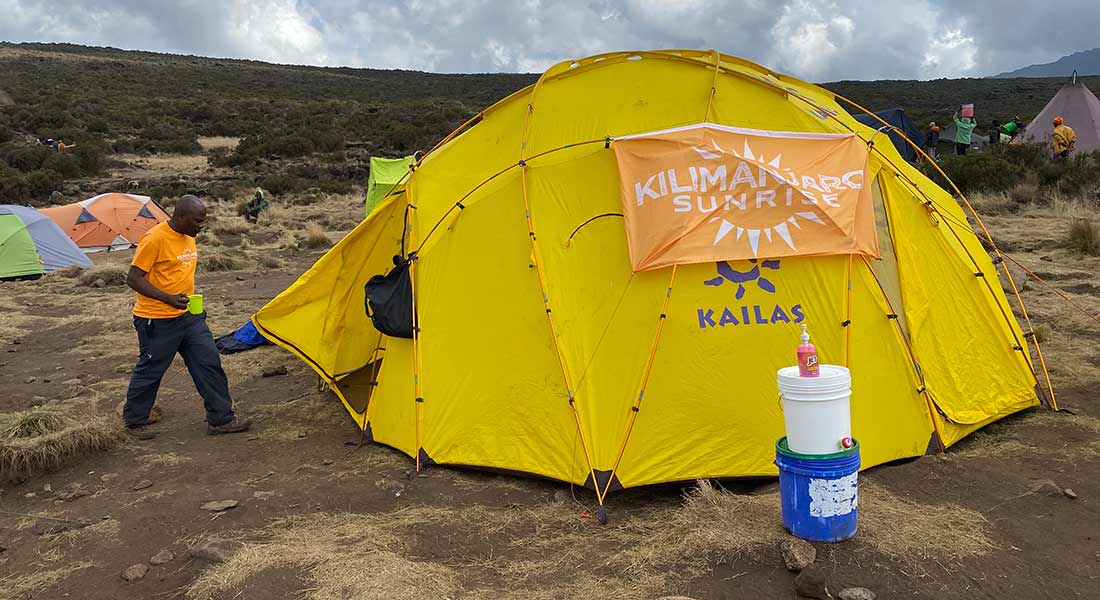
E ach morning begins with a friendly wake up by your “waiter” around 6:30 AM. If you request it, he’ll be there with coffee or tea in hand. Next to your tent will be a bowl of warm water to wash up. Once you are dressed and packed up, you can join the rest of the group in the dining tent. Meanwhile, while you are eating, the porters will pack up your tent and take off to the next campsite. We have a porter whose job is to run ahead to make sure we get the best camping spots.
During breakfast, our porter will fill your water bladder so as soon as you are done eating you can start hiking. It is usually around 8:00 AM.
One of the things that’ll take a bit to get used to is the deliberately slow pace. Our guides keep you walking slowly to make sure your body can adjust to the extreme elevation gain. It may take a few days to get used to this pace. If you hike too fast they will remind you to go slow by saying “Pole, Pole” which is Swahili for slowly, slowly.
Along the way, you’ll take numerous short breaks to eat snacks, drink water, drop or add clothing layers, and go to the bathroom. You should carry toilet paper and/or wipes with you since there are no bathrooms along the trail. Our guides will continuously monitor you to make sure you are doing okay with the altitude. Most days you’ll end up at camp in the early afternoon.
If you are an avid hiker the daily hikes are not very difficult. The trails are usually fairly steady and safe. Park personnel maintain the trails. The short hikes are designed to allow your body the most amount of time to acclimate to the elevation. Hiking Kilimanjaro requires no technical skills. Depending on the route there are only a few spots that have some exposure that may scare people. But if you listen to the guide you’ll be fine. We will have someone with you at all times. There is no chance of getting lost or left behind.
Once you arrive at camp, food and water will be ready for you. Your tent will already be up. If you rented one, the private toilet tent will as well. Before dinner, another bowl of warm water will be made available for you to wash up.
After dinner, the guide will give a health check. They will monitor your vitals and log them. If you are having any issues such as headaches, blisters, diarrhea, etc., let the guide know. It is very important that you communicate with the guide. After the health check, he will also go over what the next day’s schedule will be and how much water to bring. You are then on your own until you decide to go to sleep. Most people do so around 8 to 9 PM.

If you are an avid hiker the daily hikes are not very difficult.”
WHAT IS THE SUMMIT NIGHT SCHEDULE?
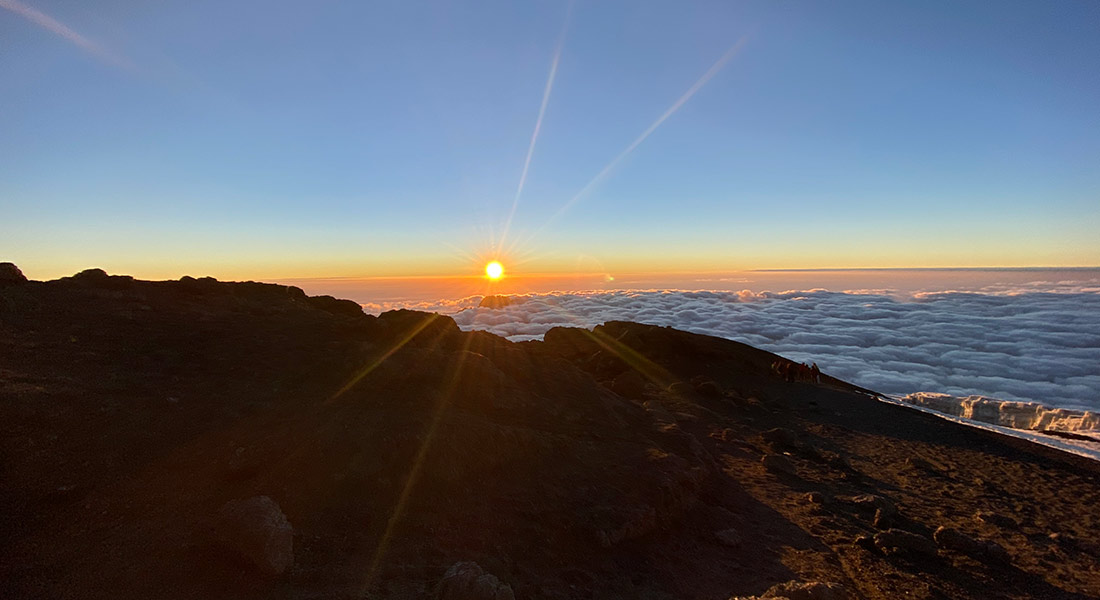
S ummit night starts with the guide or waiter tapping on your tent around 11 PM. Before going to bed, you should have laid out all the clothes you plan on wearing. This will make it easier once you awake. You’ll then grab breakfast and gear up for the final summit push.
You should dress in several layers to block the cold and wind. Clothing should have four layers on top and two or three layers on the bottom. Conditions are typically very cold at this altitude and hour. Your day pack should be the lightest it has been since you’ll need the space to shed layers on the way down. The ascent to the crater rim takes about 6-8 hours. You’ll take breaks as you plod along the switchbacks. Our guides will be especially cognizant of everyone’s health at this extreme elevation because this is where people have the most problems. If necessary, our guides will separate the group into smaller groups based on their walking speed. If anyone cannot continue, an assistant guide will take them to base camp to rest and recover. The rest of the group will continue.
Depending on the route, you’ll reach either Stella or Gilman Point after several hours. There is a wooden sign there that marks this location. This is the end of the steepest part of the trail. Once you reach the crater rim you can take a break and enjoy the stunning views. You’ll be standing on the edge of the crater and have 360° views of the mountain. The views of Mawenzi Peak, Mount Meru, and the rainforest clouds below are spectacular. From here you only have 40-60 minutes left to the summit. The trail is much more gradual from this point on. You will pass by the majestic Southern Icefields with amazing views of the glaciers.
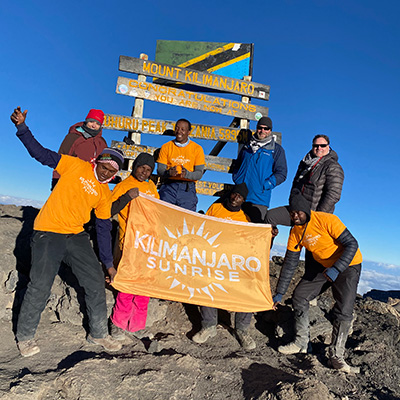
THE SUMMIT

A wooden sign marks Uhuru Peak. On most days there is a short line of people waiting to take photos. You’ll wait your turn at the sign, taking photos and videos, and marveling at what you have accomplished. Take this time to take as many photos and videos as you can. Then take more. Once you are home, you’ll wish you had more.
Now that the sun is up, you’ll probably remove some of your layers for the descent. After about 30-45 minutes at the summit, you’ll start your descent to base camp.
The descent is down a long scree slope. This is where trekking poles will be crucial. You’ll need them to keep you upright both from the tricky terrain and your level of exhaustion. See how to use them here:
Finally, you’ll arrive back at base camp. At this time you can take a break, get some food, and depending on the time maybe even a nap. After a bit, you’ll continue down the trail to a lower camp below 10,000 ft to allow your body to recover from the elevation. This descent is rocky and long and many feel this is the hardest part of the entire trek.
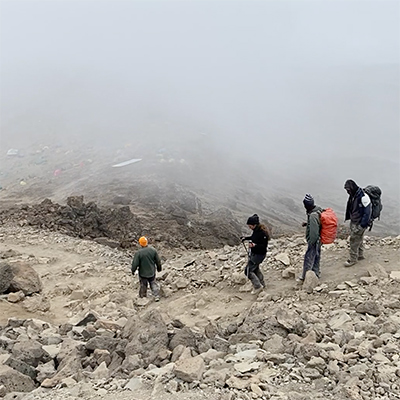
Descending from the summit goes remarkably fast.”
